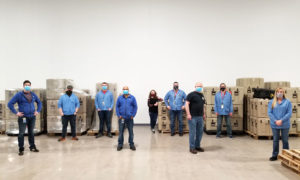Larger auto dealerships such as Burritt Motors in Oswego becoming staple in industry
By Lou Sorendo
The common stereotypes of the hard-selling, slick-talking car salesperson are quickly diminishing in the midst of an industry that is featuring internet shopping and transparent pricing.
Retailing is rapidly changing for many car dealers and their bottom lines, according to McKinsey & Company, a management consulting firm with a global presence. Its website claims two forces are limiting dealer profits.
First, automakers continue to boost incentive pressure as they face growing price competition and as a result, squeeze the margins of their dealer networks.
Second, third party digital channels for research and digital-vehicle purchases are increasing vehicle pricing transparency and enabling consumers to make product comparisons easier.
In light of these factors, Richard A. Burritt, president of R.M. Burritt Motors Inc. and Burritt Chrysler Dodge Jeep Ram in Oswego, is on a mission to create a new, exciting and different experience.
Burritt Motors is constructing a $10 million Chrysler Dodge Jeep Ram dealership, with a stand-alone showroom for Jeep; a stand-alone collision and accessories center that will be five times the capacity than what is featured today; a touchless car wash; a detail center; an Express Lube & Service Center; and a rustproofing and undercoating facility.
The business will also be installing spray-in truck bedliners. It is going to be located next to the Chevy-Buick dealership on state Route 104 East.
Burritt said the grand opening is targeted for sometime in late March.
As of mid-January, the project was about 85% complete.
“This is a big opportunity, and I’m hopeful that it will create more opportunities for every one of my employees. That’s actually the most successful thing to me. It’s not so much the money; it’s the byproduct of doing the right thing, growing success and having each employee take part in that,” he said.
Burritt plans on taking detailing services on the road and also attending to houses, boats, RVs and docks. He has nine detailers now, and his goal is to have 20 full-time detailers by the end of the year.
“I think it’s a really good way to connect and get exposure with people without spending money. It is its own form of advertising,” he noted.
Burritt along with his wife Britanee also wants to test the market with their Locavore food trucks and eventually build a brick-and-mortar restaurant featuring the same local farm-to-table fare.
“We literally want to get to the point where we can actually hydroponically cultivate all the fruits and vegetables so we can have full sustainability,” he said.
The objective is not only to create more foot traffic, but to also offer a healthier lifestyle to his employees and customers.
Bigger the better
The days of being a small-store auto dealer are diminishing, according to Automotive News.
Regardless of geography, market size or franchise, many dealers with a single point or a small group find they must either become bigger or sell to a bigger group, Automotive News claims.
“The retail business model now favors big groups, they say, which can more easily hit factory sales targets, afford dealership improvements and achieve cost benefits,” its website states.
“It’s harder to be relevant and you have to just be so efficient. There are a lot of conglomerates coming in, so naturally, that is what we are trying to do ourselves in order to control the market,” Burritt said.
In order for the new project to be successful, Burritt said it will simply be a matter of executing the game plan.
“I have a pro forma of exactly what needs to be done,” Burritt said. “We know how many employees we need, how many customers we need to see, and how many cars we must have on the lots.
“We just have to roll up our sleeves, be humble and empathetic, listen to our employees, and build a culture where they like coming to work. That will allow them to execute.”
He also said another key will be for staff to exhibit a high level of emotional intelligence.
That ability to be aware of, control and express one’s emotions, and to handle interpersonal relationships judiciously and empathetically, is a hard trait to come by, Burritt noted.
“Nowadays, it is more about how can employees relate with others and how can they work in a team atmosphere,” he said.
“It’s really harnessing the leadership’s team ability to inspire and mentor others, and just enjoy what we do. If we can do that and execute the game plan, it will work,” he added.



